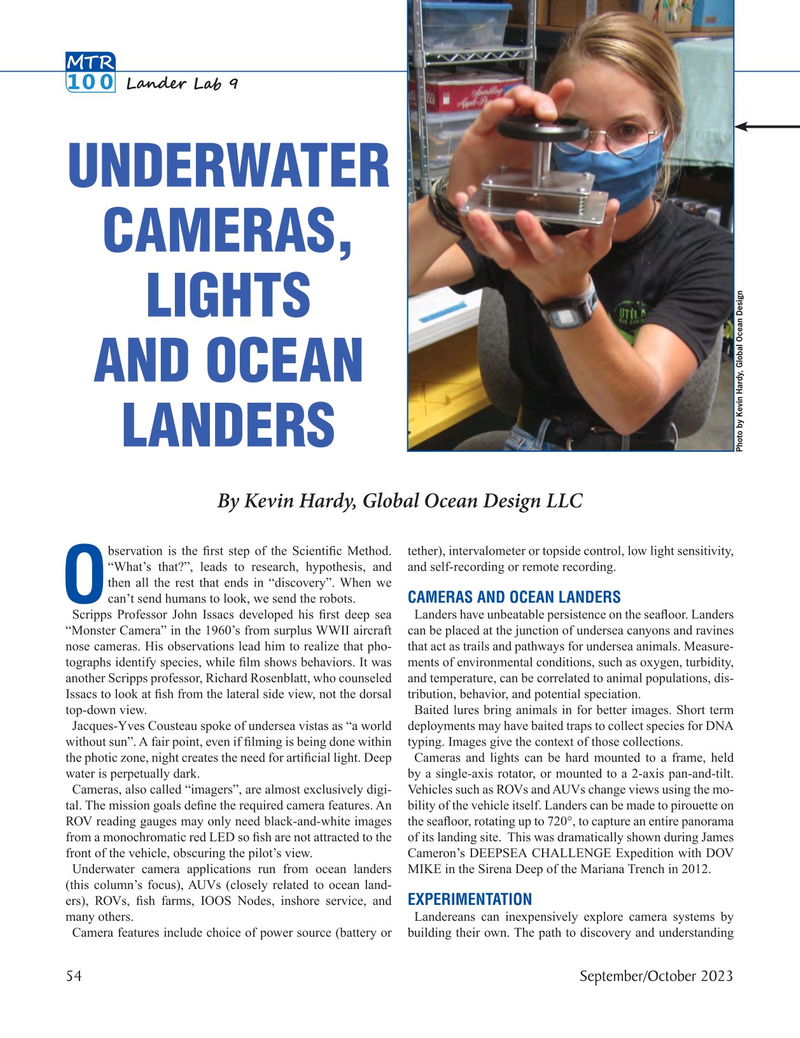
Page 54: of Marine Technology Magazine (September 2023)
Read this page in Pdf, Flash or Html5 edition of September 2023 Marine Technology Magazine
MTR
Lander Lab 9 100
UNDERWATER
CAMERAS,
LIGHTS
AND OCEAN
LANDERS
Photo by Kevin Hardy, Global Ocean Design
By Kevin Hardy, Global Ocean Design LLC bservation is the ? rst step of the Scienti? c Method. tether), intervalometer or topside control, low light sensitivity, “What’s that?”, leads to research, hypothesis, and and self-recording or remote recording.
then all the rest that ends in “discovery”. When we
Ocan’t send humans to look, we send the robots. CAMERAS AND OCEAN LANDERS
Scripps Professor John Issacs developed his ? rst deep sea Landers have unbeatable persistence on the sea? oor. Landers “Monster Camera” in the 1960’s from surplus WWII aircraft can be placed at the junction of undersea canyons and ravines nose cameras. His observations lead him to realize that pho- that act as trails and pathways for undersea animals. Measure- tographs identify species, while ? lm shows behaviors. It was ments of environmental conditions, such as oxygen, turbidity, another Scripps professor, Richard Rosenblatt, who counseled and temperature, can be correlated to animal populations, dis-
Issacs to look at ? sh from the lateral side view, not the dorsal tribution, behavior, and potential speciation.
top-down view. Baited lures bring animals in for better images. Short term
Jacques-Yves Cousteau spoke of undersea vistas as “a world deployments may have baited traps to collect species for DNA without sun”. A fair point, even if ? lming is being done within typing. Images give the context of those collections.
the photic zone, night creates the need for arti? cial light. Deep Cameras and lights can be hard mounted to a frame, held water is perpetually dark. by a single-axis rotator, or mounted to a 2-axis pan-and-tilt.
Cameras, also called “imagers”, are almost exclusively digi- Vehicles such as ROVs and AUVs change views using the mo- tal. The mission goals de? ne the required camera features. An bility of the vehicle itself. Landers can be made to pirouette on
ROV reading gauges may only need black-and-white images the sea? oor, rotating up to 720°, to capture an entire panorama from a monochromatic red LED so ? sh are not attracted to the of its landing site. This was dramatically shown during James front of the vehicle, obscuring the pilot’s view. Cameron’s DEEPSEA CHALLENGE Expedition with DOV
Underwater camera applications run from ocean landers MIKE in the Sirena Deep of the Mariana Trench in 2012.
(this column’s focus), AUVs (closely related to ocean land- ers), ROVs, ? sh farms, IOOS Nodes, inshore service, and EXPERIMENTATION many others. Landereans can inexpensively explore camera systems by
Camera features include choice of power source (battery or building their own. The path to discovery and understanding 54 September/October 2023
MTR #7 (50-65).indd 54 10/2/2023 3:36:21 PM

 53
53

 55
55
